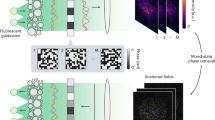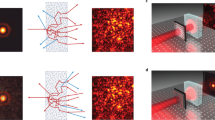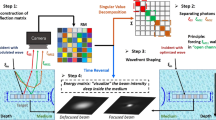Abstract
Elastic optical scattering, the dominant light-interaction process in biological tissues, prevents tissues from being transparent. Although scattering may appear stochastic, it is in fact deterministic in nature. We show that, despite experimental imperfections, optical phase conjugation (λ = 532 nm) can force a transmitted light field to retrace its trajectory through a biological target and recover the original light field. For a 0.69-mm-thick chicken breast tissue section, we can enhance point-source light return by a factor of ∼5×103 and achieve a light transmission enhancement factor of 3.8 within a collection angle of 29°. Additionally, we find that the reconstruction's quality, measured by the width of the reconstructed point source, is independent of tissue thickness (up to a thickness of 0.69 mm). This phenomenon may be used to enhance light transmission through tissue, enable measurement of small tissue movements, and form the basis of new tissue imaging techniques.
This is a preview of subscription content, access via your institution
Access options
Subscribe to this journal
Receive 12 print issues and online access
$209.00 per year
only $17.42 per issue
Buy this article
- Purchase on Springer Link
- Instant access to full article PDF
Prices may be subject to local taxes which are calculated during checkout





Similar content being viewed by others
References
Cheong, W. F., Prahl, S. A. & Welch, A. J. A review of the optical properties of biological tissues. IEEE J. Quantum Electron. 26, 2166–2185 (1990).
Leith, E. N. & Upatneiks, J. Holographic imagery through diffusing media. J. Opt. Soc. Am. 56, 523 (1966).
Levenson, M. D. High-resolution imaging by wave-front conjugation. Opt. Lett. 5, 182–184 (1980).
McFarlane, R. A. & Steel, D. G. Laser-oscillator using resonator with self-pumped phase-conjugate mirror. Opt. Lett. 8, 208–210 (1983).
Gower, M. C. KrF laser-amplifier with phase-conjugate Brillouin retro-reflectors. Opt. Lett. 7, 423–425 (1982).
Tomov, I. V., Fedosejevs, R., McKen, D. C. D., Domier, C. & Offenberger, A. A. Phase conjugation and pulse-compression of KrF-laser radiation by stimulated Raman-scattering. Opt. Lett. 8, 9–11 (1983).
Leith, E. et al. Imaging through scattering media with holography. J. Opt. Soc. Am. A 9, 1148–1153 (1992).
Jones, R. et al. Holographic storage and high background imaging using photorefractive multiple quantum wells. Appl. Phys. Lett. 69, 1837–1839 (1996).
Cuche, E., Bevilacqua, F. & Depeursinge, C. Digital holography for quantitative phase-contrast imaging. Opt. Lett. 24, 291–293 (1999).
Fink, M. Time-reversed acoustics. Sci. Am. 281, 91–97 (1999).
Lerosey, G., De Rosny, J., Tourin, A. & Fink, M. Focusing beyond the diffraction limit with far-field time reversal. Science 315, 1120–1122 (2007).
Mittra, R. & Habashy, T. M. Theory of wave-front-distortion correction by phase conjugation. J. Opt. Soc. Am. A 1, 1103–1109 (1984).
Gabor, D. A new microscopic principle. Nature 161, 777–778 (1948).
Lukosz, W. Equivalent-lens theory of holographic imaging. J. Opt. Soc. Am. 58, 1084–1091 (1968).
Zel'dovich, B. Y., Popovich, V. I., Ragul'skii, V. V. & Faizullov, F. S. Connection between wave fronts of reflected and exciting light in stimulated Mandelshtam–Brillouin scattering. JETP Lett. USSR 15, 109–113 (1972).
Hellwarth, R. W. Theory of phase conjugation by stimulated scattering in a waveguide. J. Opt. Soc. Am. 68, 1050–1056 (1978).
Ivakin, E. V., Petrovich, I. P., Rubanov, A. S. & Stepanov, B. I. Dynamic holograms in amplifying medium. Kvantovaya Elektronika 2, 1556–1558 (1975).
Gunter, P. Holography, coherent-light amplification and optical-phase conjugation with photorefractive materials. Phys. Rep. Rev. Sec. Phys. Lett. 93, 199–299 (1982).
Yariv, A. Phase conjugate optics and real-time holography. IEEE J. Quantum Electron. 14, 650–660 (1978).
Hellwarth, R. W. Generation of time-reversed wave fronts by nonlinear refraction. J. Opt. Soc. Am. 67, 1–3 (1977).
Charra, F. & Nunzi, J. M. Nondegenerate multiwave mixing in polydiacetylene—Phase conjugation with frequency-conversion. J. Opt. Soc. Am. B 8, 570–577 (1991).
Cheben, P. & Calvo, M. L. A photopolymerizable glass with diffraction efficiency near 100% for holographic storage. Appl. Phys. Lett. 78, 1490–1492 (2001).
Hoelen, C. G. A., de Mul, F. F. M., Pongers, R. & Dekker, A. Three-dimensional photoacoustic imaging of blood vessels in tissue. Opt. Lett. 23, 648–650 (1998).
Wang, X. et al. Noninvasive laser-induced photoacoustic tomography for structural and functional in vivo imaging of the brain. Nature Biotechnol. 21, 803–806 (2003).
Acknowledgements
This work was supported by the National Science Foundation career award BES-0547657 and the Defense Advanced Research Projects Agency Center for Optofluidic Integration.
Author information
Authors and Affiliations
Contributions
Z.Y. was responsible for project planning, experimental work and data analysis. D.P. provided advice and loaned some equipment for the project. M.S.F. provided advice. C.Y. was responsible for administering the project, project planning, data analysis, and obtaining financial support for the project.
Corresponding author
Supplementary information
SupplementaryInformation
Optical phase conjugation for turbidity suppression in biological samples (PDF 82 kb)
Rights and permissions
About this article
Cite this article
Yaqoob, Z., Psaltis, D., Feld, M. et al. Optical phase conjugation for turbidity suppression in biological samples. Nature Photon 2, 110–115 (2008). https://doi.org/10.1038/nphoton.2007.297
Received:
Accepted:
Published:
Issue Date:
DOI: https://doi.org/10.1038/nphoton.2007.297
This article is cited by
-
Pilot-assisted beam and correlation to recover information through scattering media [Invited]
Applied Physics B (2024)
-
Learning diffractive optical communication around arbitrary opaque occlusions
Nature Communications (2023)
-
High-gain and high-speed wavefront shaping through scattering media
Nature Photonics (2023)
-
Efficient dispersion modeling in optical multimode fiber
Light: Science & Applications (2023)
-
Phase conjugation with spatially incoherent light in complex media
Nature Photonics (2023)



